Harnessing water for beneficial uses has existed for centuries. Ancient Greeks and Romans used water in ways similar to industrial processes today – for grinding wheat, agriculture via aqueducts, and medicinal purposes. Modern hydropower or hydroelectric power has been utilized for over one hundred years and remains a clean, reliable electricity asset. As of 2019, hydropower generated roughly 6.6% of electricity for the United States (U.S.), while some states’ electricity mixes are dominated by hydropower. The Pacific Northwest relies heavily on hydropower, where the electricity mixes of Washington, Oregon, and Idaho have significant amounts of hydropower. While hydropower is generally thought of for electricity generation, only 2% of the 90,000 dams in the U.S. generate electricity.1

The first use of modern hydroelectric power was used for lighting in 1880 for a Michigan store front closely followed by street lighting in Niagara Falls, New York in 1881.2 Both of these direct uses of hydropower were for nearby lighting, while the first commercial power plant for long distance electricity carrying was built in California in 1893.3 The first pumped storage hydropower project was built in 1929 along the Housatonic River in Connecticut to expand electricity generation from the river.4 Harnessing hydropower continued to grow prompting the creation of federal and state agencies.
The Bureau of Reclamation was created in 1902 to develop hydropower and manage water resources in the Western United States. The United States Army Corps of Engineers (USACE) initially became involved in flood control, followed by navigation and later in water management through hydroelectric development in the 1920s. Years later, organizations like the Tennessee Valley Authority were created to ensure flood control and water management mirrored population growth. Hydropower’s boom began in the 1930s with the commencement of the Hoover Dam on the Colorado River followed by the creation of the Bonneville Power Administration. As part of the economic stimulus recovery after the Great Depression, the New Deal saw hydropower development rapidly expand as a way to increase jobs.
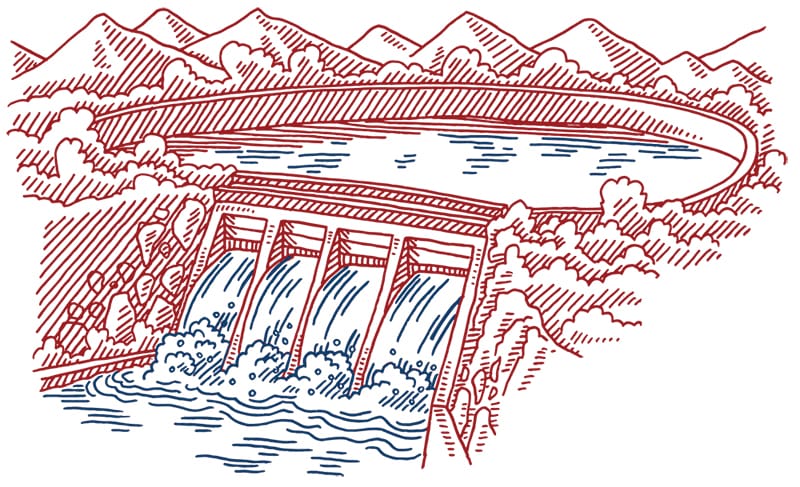
Today’s hydropower has come a long way from these early dams. Conventional hydropower, run-of-river, pumped storage, marine hydrokinetics, as well as conduit or canal hydropower resources all play important roles in generating clean electricity and enabling use of water resources across the globe.
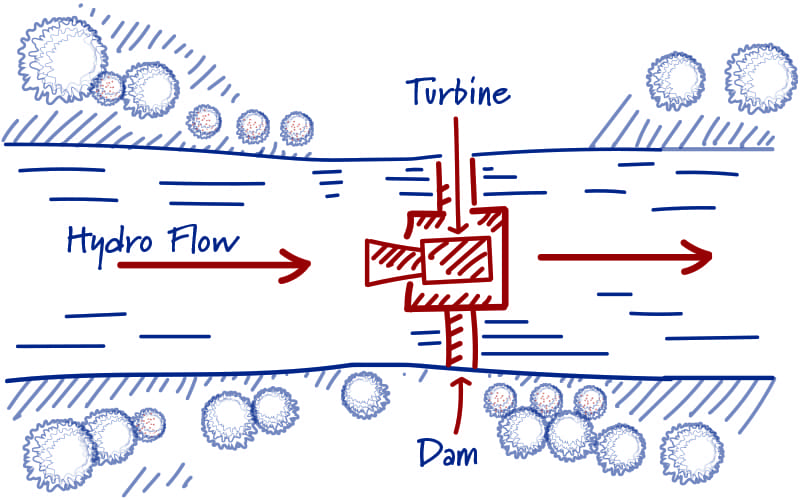
There are three main types of hydropower technologies: impoundment, diversion, and pumped storage. These varying types of technologies are illustrated throughout, as well as marine hydrokinetics, which includes wave, tidal, current, and thermal technologies.
Conventional or impoundment hydropower stores vast amounts of water behind large dams. To generate electricity water is released, which turns a turbine to generating electricity.
Run-of-river or diversion resources are not meant to store water resources; rather they use water resources alongside the river by diverting the river through channels to harness the kinetic energy. Portions of the water are channeled and run through a powerhouse, generating electricity. The water is then returned to the river, reducing environmental impacts.
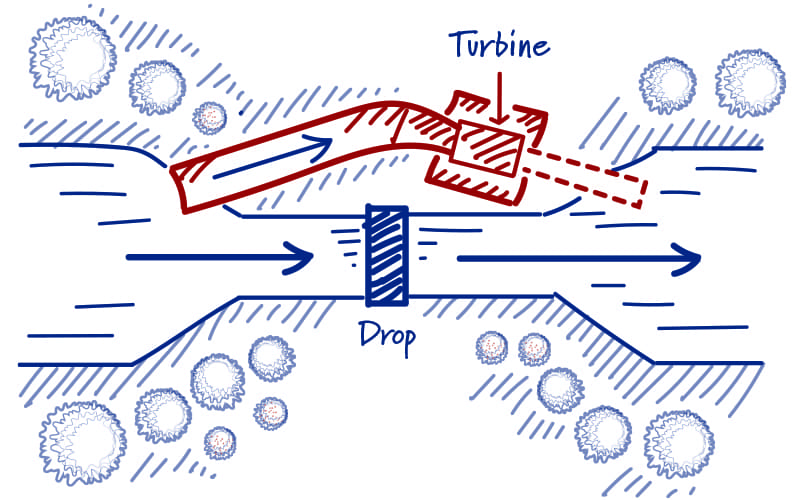
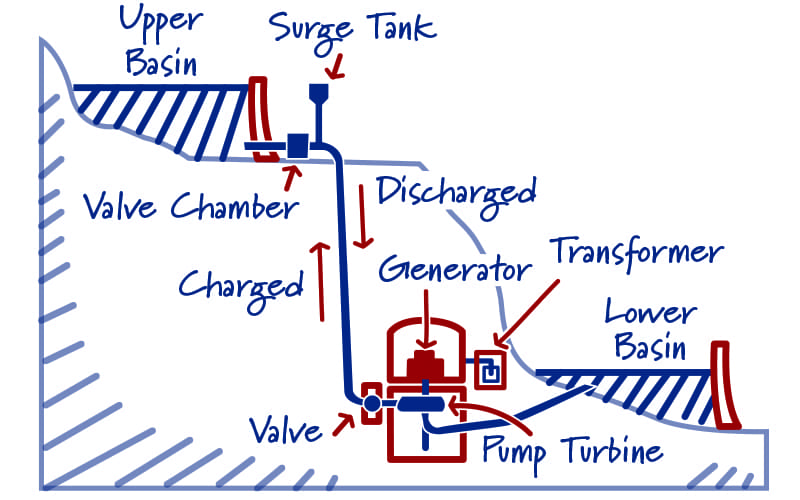
Conduit or canal hydropower resources harness energy from water resources which are diverted for other uses such as crop irrigation. The water flows through a pipe and while en route to its final destination, electricity can be generated through turbines within the pipes.
Pumped storage hydropower (PSH) uses two reservoirs, an upper reservoir and a lower reservoir with an elevation change between the two. PSH mimics a battery – to charge, water is pumped to the upper reservoir and to discharge water is released to the lower reservoir. As the water flows downstream, it passes through a turbine and generates electricity. PSH can be open-looped if it is connected to a natural body of water or closed-looped if the reservoirs are not connected to any outside bodies of water.
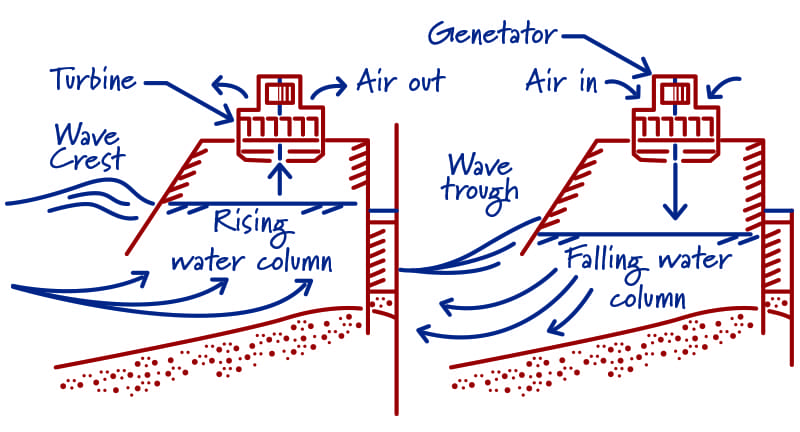
Marine hydrokinetics (MHK) harness energy from oceans and rivers in the form of wave, tidal, current, and thermal energy. Today MHK in the U.S. is still in the research and development stage, as are projects in Northern Europe and Australia.5 However, the Department of Energy is leading efforts to develop technological innovations, create international standards, and has completed a resource assessment and characterization. There are hundreds of MHK designs being tested to show both technical and economic viability while driving market acceleration and adoption.
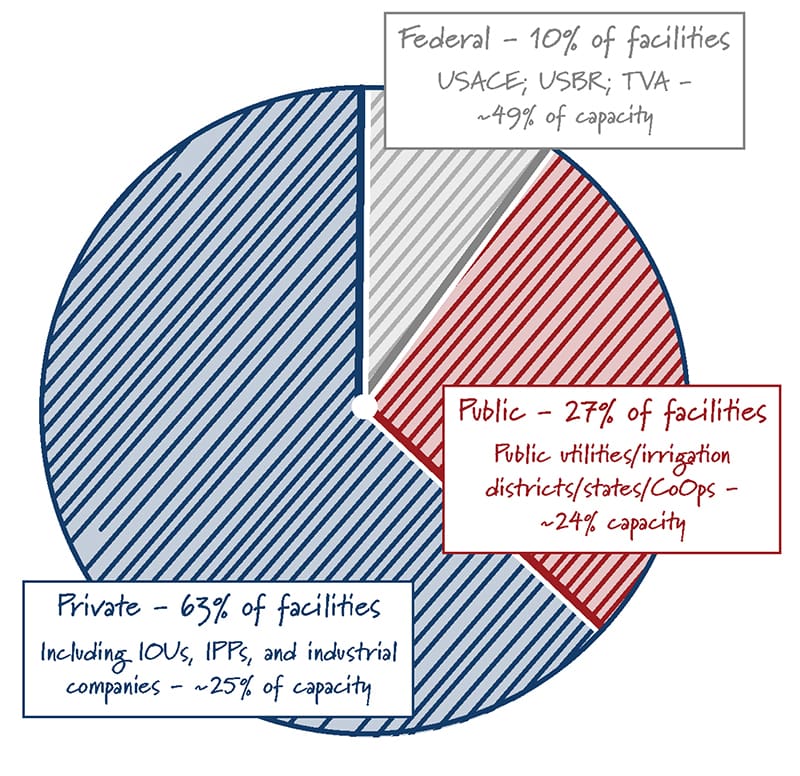
The current U.S. hydropower fleet is roughly 103 gigawatts (GW) of capacity. Ownership falls under three main categories: federal, public, and private, although some projects have hybrid ownership such as public-private and public-federal partnerships. The existing fleet provides roughly 6.6% of electricity generation. Currently 48 states have hydropower assets with the exception of Delaware and Mississippi. Significant regional differences exist; a prime example of this is the Pacific Northwest, including Washington, Oregon, and Idaho. Washington State alone generates over 70% of its electricity from hydropower. Other states have high hydropower assets as well, including Maine, New York, North Dakota and Vermont. While regional differences in weather and climate as well as topography can limit expansion of hydropower, in many cases, there are opportunities to expand hydropower assets in innovative ways. This includes the use of existing infrastructure such as powering non-powered dams or pursuing new opportunities in modular hydropower, pumped-storage hydropower, tidal energy, and wave energy. Among these assets, the U.S. Department of Energy’s (DOE) Hydropower Vision Report identifies 50 GW of additional capacity that can be added by 2050.6 That’s the equivalent of charging half a million electric vehicles or turning on five billion light bulbs.
As the U.S. looks towards the future of hydropower, significant potential lies in existing infrastructure. Adding power-generating capabilities to existing infrastructure kills two birds with one stone: increasing the penetration of reliable, clean energy while providing much-needed upgrades.
While there are many benefits associated with hydropower facilities, the average age of U.S. dams is 56 ears. Many of these are classified as either “high hazard potential” or “deficient high hazard potential,” referring to the potential of dam failure. Dams are classified as “high hazard potential” when failure could result in loss of life, or “deficient high hazard potential” where failure could result in significant economic and environmental damage. According to the American Society of Civil Engineers, just the rehabilitation of dams categorized as most critical or “high-hazard” would cost almost $22 billion.7 The USACE assessed the repair requirements for its 709 dams in 2015 and estimated a $24 billion cost to conduct the repairs.8 The following table illustrates the top ten states with “high hazard potential” dams.9
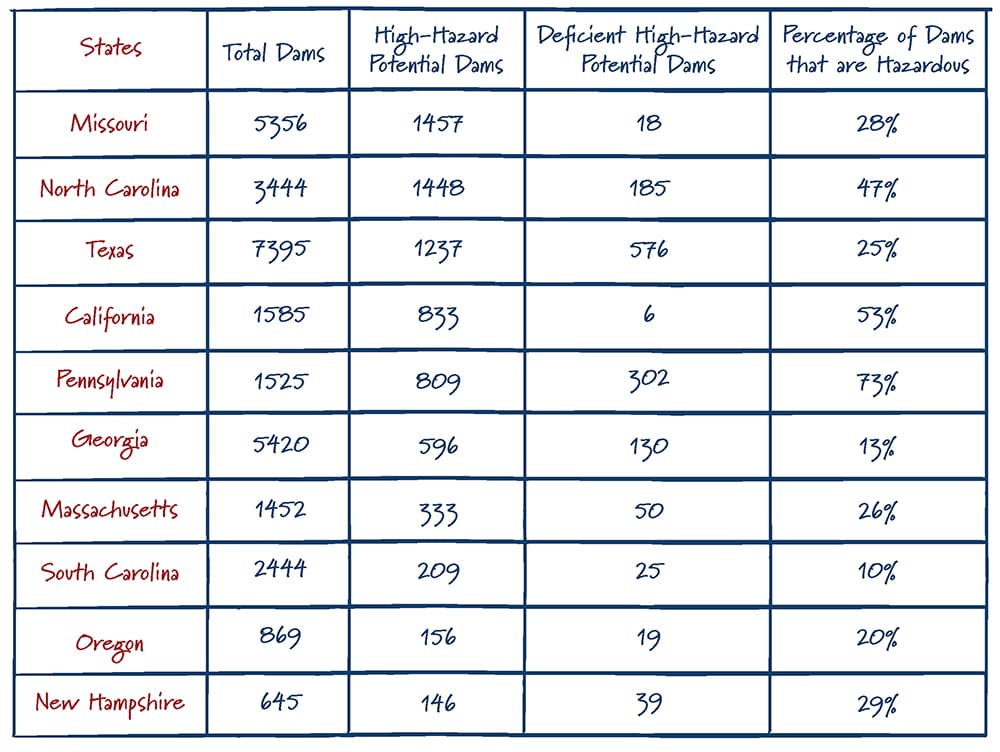
Fortunately, there is a solution. An assessment of the potential for hydropower development on existing non-powered dams was conducted by Oak Ridge National Laboratory (ORNL). Researchers at ORNL found that there was up to 12 GW (12,000 MW) of potential new capacity available in these non-powered dams. This research suggests significant growth potential in hydropower, adding clean assets to the grid in the Midwest and Central regions of the United States.10 That means necessary infrastructure improvements and renewable electricity generation can be added in tandem. Below is a table illustrating the results of the ORNL study, including the top twenty states with non-powered dams and the added hydropower capacity potential they could add to the grid.
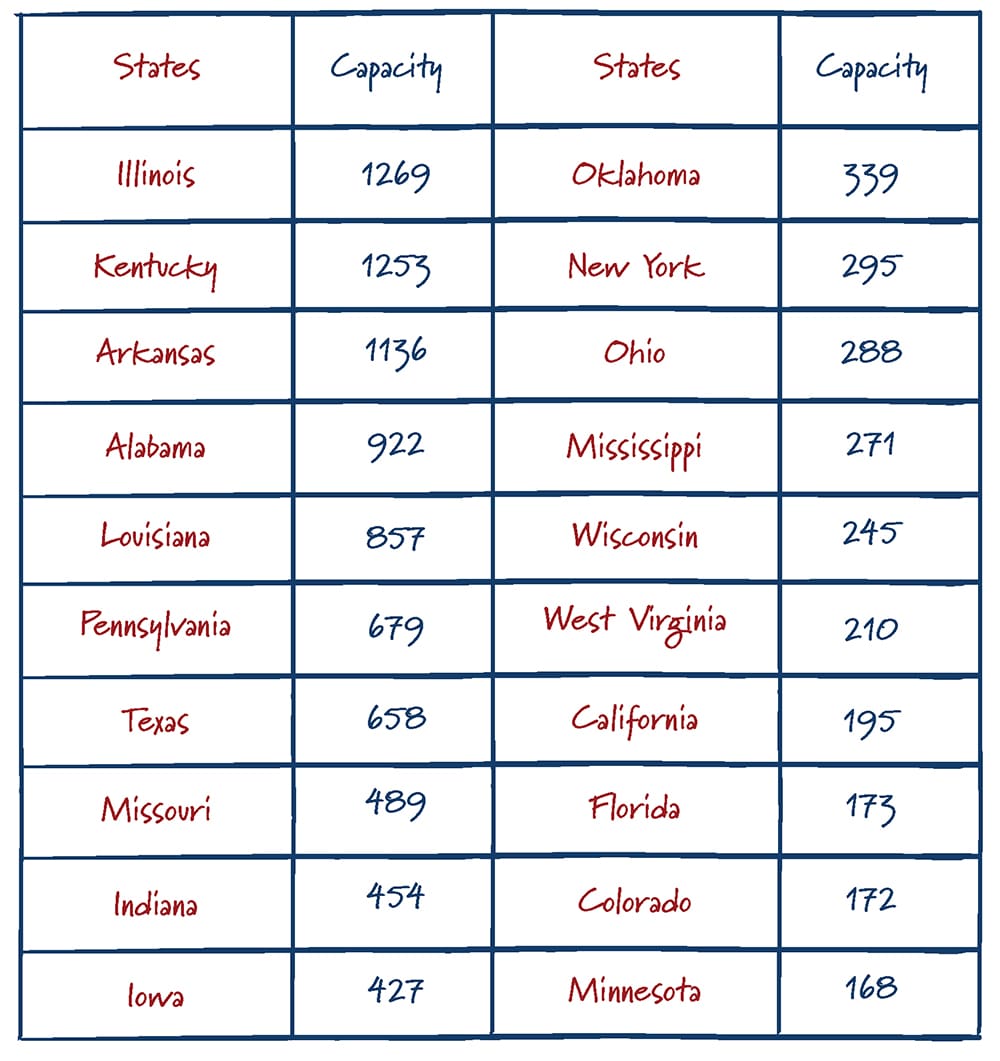
Locks for transportation and irrigation canals entail other existing infrastructure that provides a public good; locks allow for the hauling of goods via barge, a process which has a significantly lower carbon footprint compared to hauling via truck or train.11 Most of this infrastructure will not be removed in the foreseeable future, providing another strong candidate for hydropower addition.
Irrigation Canals
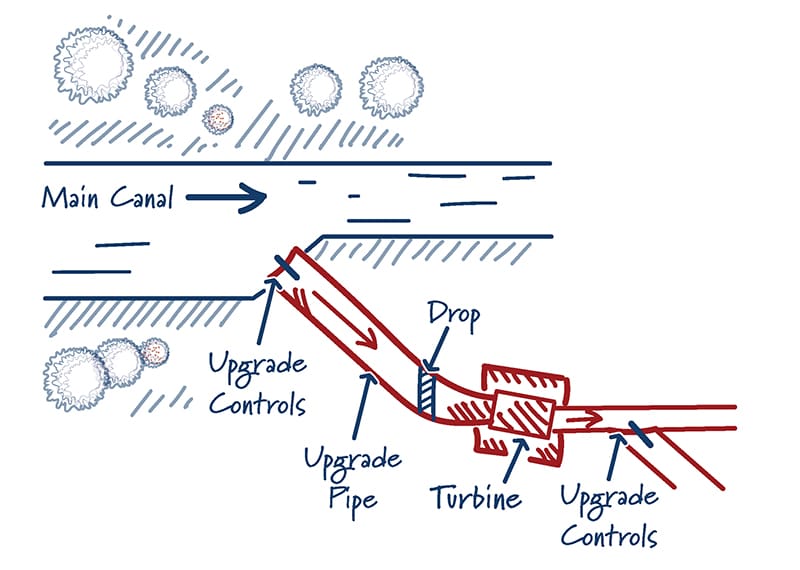
Many irrigation canals were installed more than 50 years ago and need to be repaired or upgraded. When hydropower is added to the drops in the irrigation canals, diversion structures are replaced or upgraded. Dilapidated flumes or dissipation structures are replaced with new pipes and manual controls with automated controls. The upgrades result in less water loss from reduced leakage. The precise water control also reduces irrigation water waste and increases system reliability. These upgrades can also increase water quality into the local streams and rivers by reducing destructive sediment and mineral suspension.
Encouraging the private sector to power non-hydroelectric dams, locks and irrigation canals while upgrading and repairing existing infrastructure provides a clear public-private partnership opportunity, which can significantly improve aging infrastructure, protecting property and lives.12 While some of the infrastructure may be removed in the coming years, most will not be removed and needs to be repaired because of the multiple uses the infrastructure provides. Finding creative means to expedite the water infrastructure repairs will help create jobs, improve the infrastructure, and provide reliable and clean hydroelectric power.
With so many roles to play, hydropower faces a comprehensive regulatory process. The Federal Energy Regulatory Commission (FERC) has authority over non-federal hydropower facilities. This authority comes from the Federal Power Act, which entitles FERC to issue licenses to construct and operate non-federal hydropower facilities. Because of environmental and use concerns, the Federal Power Act also nods to the jurisdiction of all the other agencies involved in protecting and regulating U.S. waters — over a dozen federal and state agencies.13,14 For example, if a project involves a USACE dam, the Corps can establish protocols for flood control operations and measures to allow for commercial navigation.15 Sometimes these agencies, particularly state and federal, have different standards for environmental protection, requiring additional coordination; this addition stretched the relicensing process for California facility Don Pedro to a decade, for example.16
If a project is entirely on private land, has no complex environmental or resource issues, and submits all documents on time, the licensing process can take five years or fewer from the first document submitted to the final license issuing.17 This timeline can stretch when there are deviations, as mentioned above, or with non-traditional facilities, such as power generation at non-power dams, pilot facilities to test marine hydrokinetic technology, or closed-loop pumped storage projects. The licensing for these projects often takes a decade or more, often depending on project size although not exclusively: one 70 kW marine hydrokinetic project took a decade from preliminary permit to license.18 Another marine hydrokinetic project, a 20 MW pilot, shortened this process to six years by engaging a dozen agencies years before filing for an application.19
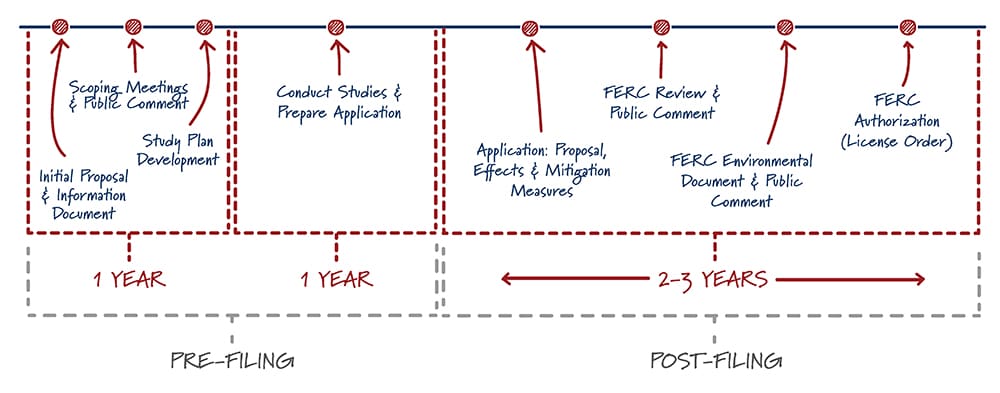
Both constructing and operating hydropower provides benefits far beyond low environmental impact electricity. Developing hydropower projects on existing water infrastructure can provide additional benefits, including upgrading and repairing infrastructure such as locks and dams, and improving water quality.20
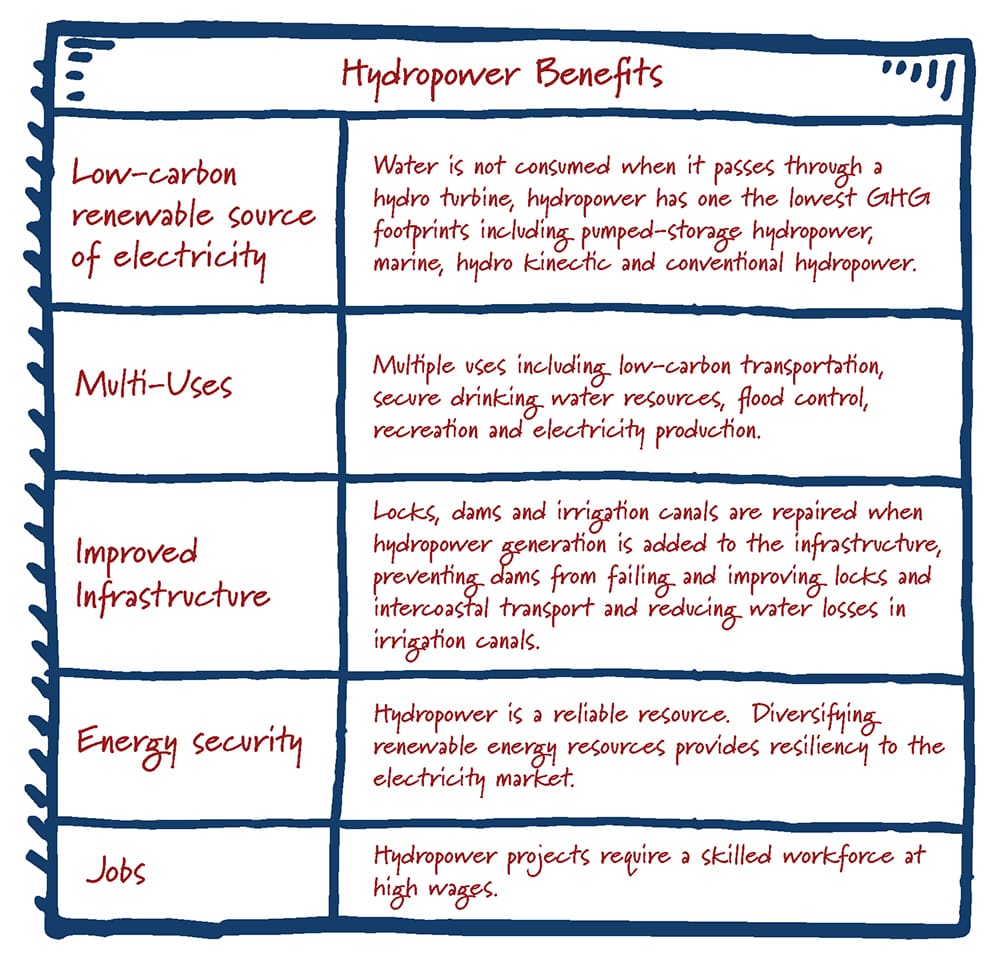
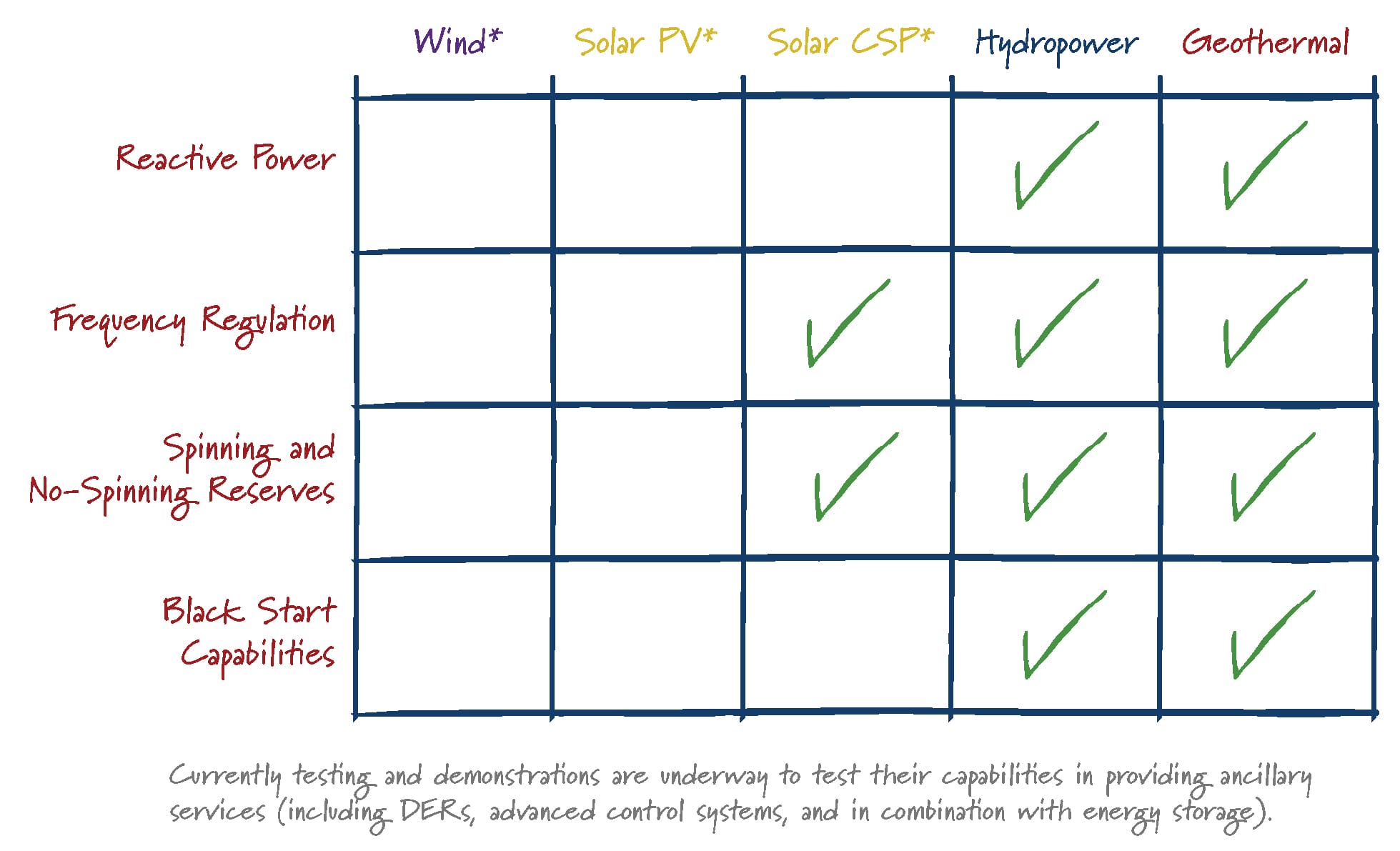
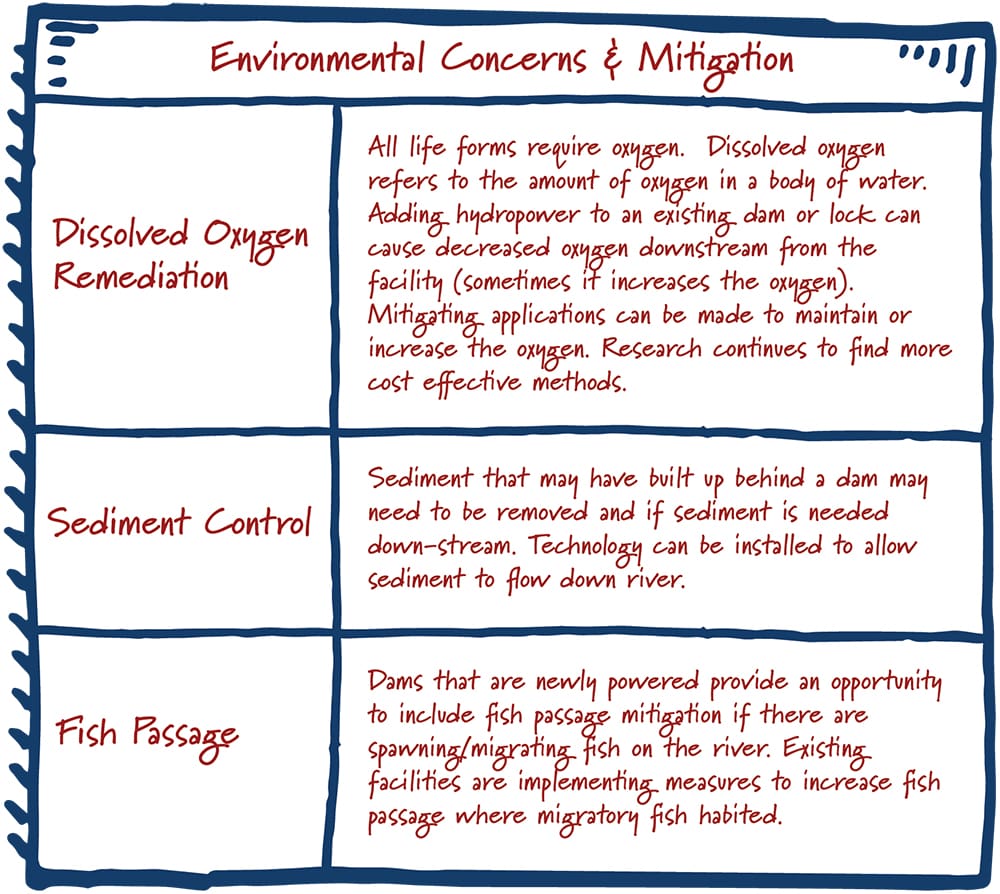
To take advantage of the country’s significant hydropower potential, the U.S. federal government is exploring ways to expand and optimize hydropower capabilities in the United States.
At a federal level, research and development for hydropower lies in the DOE’s Water Power Technologies Office (WPTO).21 The WPTO works with national labs, universities, industry and other federal agencies to research, develop, and fund or help fund projects to expand hydropower as a whole. The WPTO published the Hydropower Vision Report in 2017 as well as other similar reports in collaboration with national labs highlighting growth opportunities for the hydropower industry. As illustrated in the map below there are six national laboratories with hydropower expertise: Argonne National Laboratory (ANL), Idaho National Laboratory (INL), National Renewable Energy Laboratory (NREL), Oak Ridge National Laboratory (ORNL), Pacific Northwest National Laboratory (PNNL) and Sandia National Laboratories (SNL).22
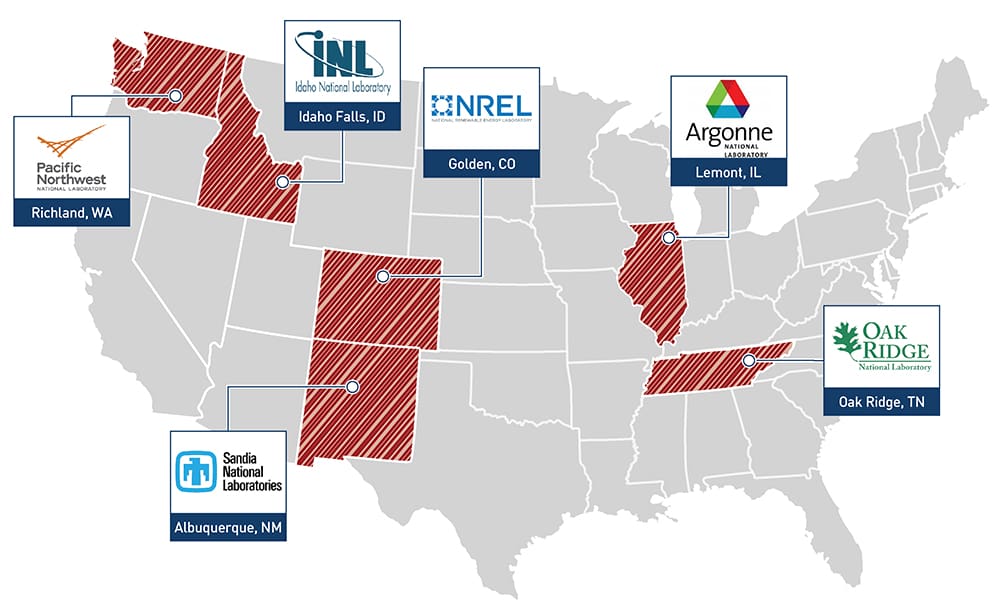
ANL scientists are working with industry to develop next-generation conventional and pumped storage hydropower technologies while improving the efficiency of existing operations. ANL has published on the valuation of PSH and has studied the techno-economics of PSH.23 INL is known for nuclear energy; however, researchers there are considered experts in electrical power generation and distribution of renewable energy development. INL’s researchers are currently applying their expertise to the development of a river-based hydropower system incorporating energy storage.24 NREL has workstreams and expertise in both hydropower and marine hydrokinetics, utilizing in house testing capabilities and facilities. NREL’s team is developing a regulatory roadmap to further opportunities in hydropower and PSH.25 ORNL is focused on cost reduction and increased performance. PNNL’s proximity to the Bonneville Power Administration and research in grid resiliency aids in their expertise for MHK and hydropower research. SNL’s team is improving the environmental impact of wave energy converters. Because of SNL’s nuclear energy expertise, they are utilizing materials science to improve reliability and performance in harsh environments. In most cases, the research at the National Labs are focused on innovative solutions for the future while considering ways to utilize existing infrastructure.
Research and development (R&D) continues to drive innovations in efficiency of the existing fleet, while encouraging development of new technologies including turbines and ways to improve environmental impacts.26 Hydropower plays a unique role in clean energy while providing additional value in ancillary services such as load-following, spinning reserves, reactive power, and black start services.
Tapping into additional hydropower may not require new large scale projects similar to conventional hydropower, which means building new large dams can be removed from the equation. Instead, existing dams could be powered and significant efficiency gains in the existing fleet through upgrades and new technologies can be pursued, both of which are viewed as better for the natural environment. New opportunities to harness additional energy from hydropower exist across a spectrum of technologies, allowing hydropower to play a critical role in clean energy generation for decades to come.27
Hydropower and pumped storage hydropower have seen growth throughout many parts of the world due to countries pursuing stable electricity with low greenhouse gas emissions. Hydropower is very often one component of a comprehensive development of water resources, which can also include dams for water supply, storage or diversion for irrigation, sediment control, flood control, as well as recreational opportunities. Additionally, income from the energy produced can be a significant source of support for the other project purposes that enhance the value of water. Many large hydropower developments around the world are thus multi-purpose investments, improving the lives of millions of people.
Hydropower represents approximately 16% of the total electricity production in the world with China possessing the most capacity, three times more than the second largest, Brazil. The following pie chart shows the top five countries with the largest installed hydropower capacity.29 China installed the most new capacity in 2019, 8,540 MW compared to Brazil with 3,866 MW. Brazil’s development launched its hydropower capacity past the United States, which now ranks third. North and Central America had the least new installed capacity compared to all other regions, in large part due to the stagnation of hydropower development in the United States.
Hydropower Capacity by Country
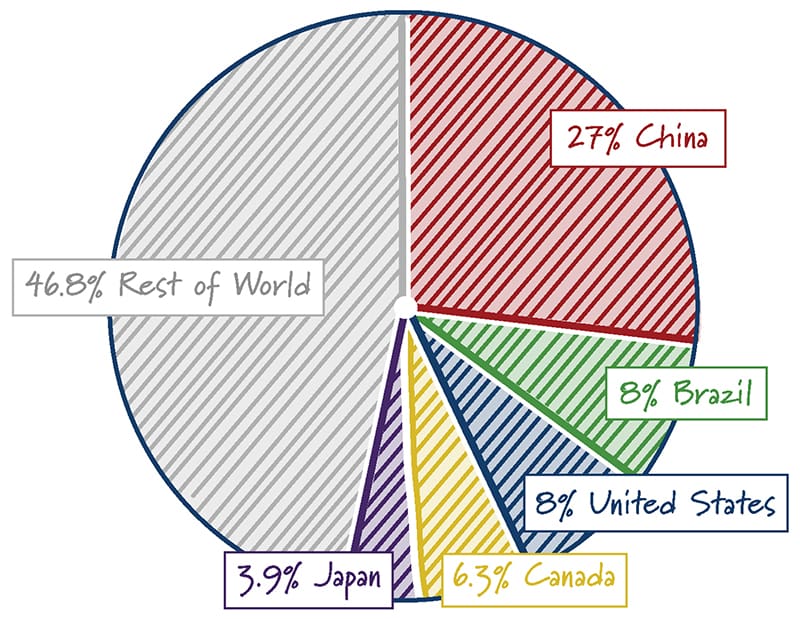
While China has the greatest capacity of hydropower, other countries have a higher percentage of hydropower in their electricity mixes. Norway, Paraguay and Canada provide significant electricity for neighboring countries. The Nord Pool, a regional power market in operation since 1996 allows Norway, Finland, Sweden, Denmark and the Baltics to transmit and share power, helping to reduce the amount of new power generation required and increasing electric grid stability. Paraguay shares two hydropower facilities, one with the government of Brazil and the second with Argentina and as a result exports close to 70% of the hydroelectricity it produces.30
Significant potential for hydropower development exists in all regions of the world. Developing economies represent the most significant potential for new hydropower generation. The African region is expected to increase its hydropower capacity by over 40 GW within five years. East and South Asia, most notably China and India will continue to develop their resources while at the same time working to develop cross border transmission and market systems. In North America, Canada is focussing on powering indigenous regions with small/micro hydropower as well as adding another 2,900 MW of hydropower capacity in the next five years through four major projects that are under construction; these projects will export power to the United States.
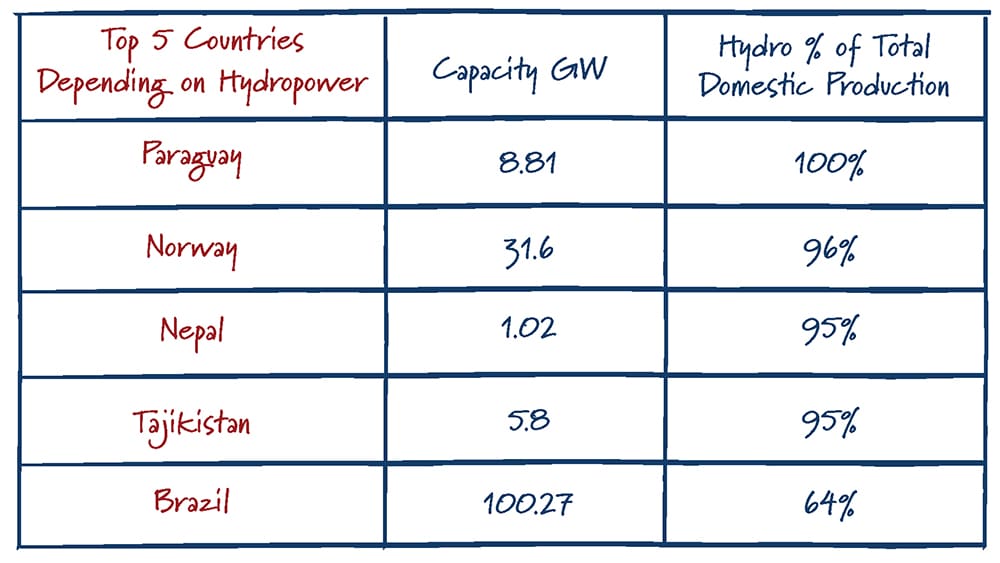
The United States is one of the few OECD countries that is not fully supportive of hydropower projects, due in part to public perception of hydropower, policies that support other energy resources and the lengthy regulatory process.31 However, U.S. Department of Energy sponsored studies have shown tremendous potential through new hydropower technologies and existing infrastructure.
